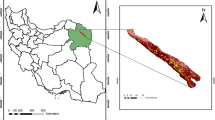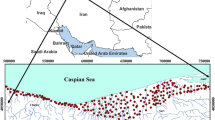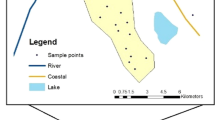Abstract
Groundwater is an especially important freshwater source for water supplies in the Maku area of northwest Iran. The groundwater of the area contains high concentrations of fluoride and is, therefore, important in predicting the fluoride contamination of the groundwater for the purpose of planning and management. The present study aims to evaluate the ability of the extreme learning machine (ELM) model to predict the level of fluoride contamination in the groundwater in comparison to multilayer perceptron (MLP) and support vector machine (SVM) models. For this purpose, 143 water samples were collected in a five-year period, 2004–2008. The samples were measured and analyzed for electrical conductivity, pH, major chemical ions and fluoride. To develop the models, the data set—including Na+, K+, Ca2+ and HCO3 − concentrations as the inputs and fluoride concentration as the output—was divided into two subsets; training/validation (80% of data) and testing (20% of data), based on a cross-validation technique. The radial basis-based ELM model resulted in an R 2 of 0.921, an NSC of 0.9071, an RMSE of 0.5638 (mg/L) and an MABE of 0.4635 (mg/L) for the testing data. The results showed that the ELM models performed better than MLP and SVM models for prediction of fluoride contamination. It was observed that ELM models learned faster than the other models during model development trials and the SVM models had the highest computation time.






Similar content being viewed by others
References
Abdullah SS, Malek MA, Abdullah NS, Kisi O, Yap KS (2015) Extreme learning machines: a new approach for prediction of reference evapotranspiration. J Hydrol 527:184–195
Adamowski JF, Sun K (2010) Development of a coupled wavelet transform and neural network method for flow forecasting of non-perennial rivers in semi-arid watersheds. J Hydrol 390(1–2):85–91
Aghbashlo M, Shamshirband S, Tabatabaei M, Yee PL, Larimi YN (2016) The use of ELM–WT (extreme learning machine with wavelet transform algorithm) to predict exergetic performance of a DI diesel engine running on diesel/biodiesel blends containing polymer waste. Energy 94:443–456
Alagha JS, Said MAM, Mogheir Y (2014) Modeling of nitrate concentration in groundwater using artificial intelligence approach—a case study of Gaza coastal aquifer. Environ Monit Assess 186(1):35–45
Al-Anazi AF, Gates ID (2010) Support vector regression for porosity prediction in a heterogeneous reservoir: a comparative study. Comput Geosci 36:1494–1503
Al-Mahallawi K, Mania J, Hani A, Shahrour I (2012) Using of neural networks for the prediction of nitrate groundwater contamination in rural and agricultural areas. Environ Earth Sci 65(3):917–928
Al-Shammari ET, Keivani A, Shamshirband S, Mostafaeipour A, Yee PL, Petkovic D, Sudheer CH (2016) Prediction of heat load in district heating systems by support vector machine with Firefly searching algorithm. Energy 95:266–273
American Public Health Association (1998) Standard method for the examination of water and wastewater, 17th edn. American Public Health Association, Washington
Amirmojahedi A, Mohammadi K, Shamshirband S, Danesh AS, Mostafaeipour A, Kamsin A (2016) A hybrid computational intelligence method for predicting dew point temperature. Environ Earth Sci 75:415. doi:10.1007/s12665-015-5135-7
Amini M, Johnson A, Abbaspour KC, Mueller K (2009) Modeling large scale geogenic contamination of groundwater, combination of geochemical expertise and statistical techniques. 18th World IMACS/MODSIM Congress, Cairns, pp 4100–4106
Asghari Moghaddam A, Fijani E (2007) Hydrogeologic and hydrochemical studies of Maku Area basaltic and karstic aquifers in relation to geological formations (in Persian). Sci Q J Geosci 17(67):2–13
Asghari Moghaddam A, Fijani E (2008) Distribution of fluoride in groundwater of Maku area, northwest of Iran. Environ Geol 56:281–287
Asghari Moghaddam A, Fijani E (2009) Hydrogeologic framework of the Maku area basalts, northwestern Iran. Hydrogeol J 17:949–959
Asghari Moghaddam A, Jomeiri R, Mohamadi A (2005) Investigation of hydrogeologic characteristics of Maku area basaltic rocks for optimum groundwater management using geophysical, RS and GIS methods (in Persian). University of Tabriz, Tabriz
Asghari Moghaddam A, Jomeiri R, Mohamadi A (2007) Source of high fluoride in groundwater of basaltic lavas of Bazargan–Poldasht Plains and its ill effects on human health (in Persian). J Environ Stud (University of Tehran) 33:25–32
Ayoob S, Gupta AK (2006) Fluoride in drinking water: A review on the status and stress effects. Crit Rev Environ Sci Technol 36:433–487
Barbier O, Arreola-Mendoza L, Del Razo LM (2010) Molecular mechanisms of fluoride toxicity. Chem Biol Interact 188:319–333
Barzegar R, Adamowski J, Asghari Moghaddam A (2016a) Application of wavelet-artificial intelligence hybrid models for water quality prediction: a case study in Aji-Chay River, Iran. Stoch Environ Res Risk Assess. doi:10.1007/s00477-016-1213-y
Barzegar R, Asghari Moghaddam A (2016) Combining the advantages of neural networks using the concept of committee machine in the groundwater salinity prediction. Model Earth Syst Environ. doi:10.1007/s40808-015-0072-8
Barzegar R, Asghari Moghaddam A, Baghban H (2016b) A supervised committee machine artificial intelligent for improving DRASTIC method to assess groundwater contamination risk: a case study from Tabriz plain aquifer, Iran. Stoch Environ Res Risk Assess 30(3):883–899
Barzegar R, Sattarpour M, Nikudel MR, Asghari Moghaddam A (2016c) Comparative evaluation of artificial intelligence models for prediction of uniaxial compressive strength of travertine rocks, case study: Azarshahr area, NW Iran. Model Earth Syst Environ. doi:10.1007/s40808-016-0132-8
Belayneh A, Adamowski J (2012) Standard Precipitation Index drought forecasting using neural networks, wavelet neural networks, and support vector regression. Appl Comput Intell Soft Comput 2012:794061. doi:10.1155/2012/794061
Belayneh A, Adamowski J, Khalil B (2016) Short-term SPI drought forecasting in the Awash River Basin in Ethiopia using wavelet transforms and machine learning methods. Sustain Water Resour Manag 2(1):87–101
Belayneh A, Adamowski J, Khalil B, Ozga-Zielinski B (2014) Long-term SPI drought forecasting in the Awash River Basin in Ethiopia using wavelet-support vector regression models. J Hydrol 508:418–429
Cerklewski FL (1997) Fluoride bioavailability: nutritional and clinical aspects. Nutr Res 17:907–929
Chang FJ, Tsai WB, Chen HK, Yam RSW, Herricks EE (2013) A self-organizing radial basis network forestimating riverine fish diversity. J Hydrol 476(1):280–289
Chau K (2006) A review on integration of artificial intelligence into water quality modelling. Mar Pollut Bull 52:726–733
Chitsazan N, Nadiri AA, Tsai FTC (2016) Prediction and structural uncertainty analyses of artificial neural networks using hierarchical Bayesian model averaging. J Hydrol 528:52–62
Cho KH, Sthiannopkao S, Pachepsky YA, Kim KW, Kim JH (2011) Prediction of contamination potential of groundwater arsenic in Cambodia, Laos, and Thailand using artificial neural network. Water Res 45(17):5535–5544
Chowdhury M, Alouani A, Hossain F (2010) Comparison of ordinary kriging and artificial neural network for spatial mapping of arsenic contamination of groundwater. Stoch Environ Res Risk Assess 24(1):1–7
Cigizoglu HK (2003) Estimation, forecasting and extrapolation of flow data by artificial neural networks. Hydrol Sci J 48(3):349–361
Coppola EA Jr, Rana AJ, Poulton MM, Szidarovszky F, Uhl VW (2005) A neural network model for predicting aquifer water level elevations. Ground Water 43(2):231–241
Dar IA, Sankar K, Dar MA, Majumder M (2012) Fluoride contamination - Artificial neural network modeling and inverse distance weighting approach. J Water Sci 25(2):165–182
Ding S, Zhang J, Xu X, Zhang Y (2016) A wavelet extreme learning machine. Neural Comput Appl 27(4):1033–1040
Domenico PA, Schwartz FW (1990) Physical and Chemical Hydrogeology. Wiley, New York, p 824
Dongwen CUI (2013) Application of extreme learning machine to total phosphorus and total nitrogen forecast in lakes and reservoirs. Water Resour Prot 29(2):61–66. doi:10.3969/j.issn.1004-6933.2013.02.013
Ebtehaj I, Bonakdari H, Shamshirband S, Mohammadi K (2016) A combined support vector machine-wavelet transform model for prediction of sediment transport in sewer. Flow Meas Instrum. doi:10.1016/j.flowmeasinst.2015.11.002
EPA (1997) Public health global for fluoride in drinking water. Pesticide and environmental toxicology. Section Office of Environmental Health Hazard Assessment, California Environmental Protection Agency
Fernández-Delgado M, Cernadas E, Barro S, Ribeiro J, Neves J (2014) Direct kernel perceptron (DKP): ultra-fast kernel ELM-based classification with noniterative closed-form weight calculation. Neural Netw 50:60–71
Fernando DAK, Shamseldin AY (2009) Investigation of internal functioning of the radial-basis-function neural network river flow forecasting models. J Hydrol Eng 14(3):286–292
Fijani E (2007) Investigation of hydrogeology and hydrochemistry of basaltic-alluvial aquifers in Bazarganand Poldasht Plains, MSc Thesis. University of Tabriz, Iran. (in Persian).
Fijani E, Nadiri A, Asghari Moghaddam A, Tsai FT-C, Dixon B (2013) Optimization of DRASTIC method by supervised committee machine artificial intelligence to assess groundwater vulnerability for Maragheh-Bonab plain aquifer. Iran. J Hydrol 503:89–100
Goyal MK, Bharti B, Quilty J, Adamowski J, Pandey A (2014) Modeling of daily pan evaporation in sub-tropical climates using ANN, LS-SVR, Fuzzy Logic, and ANFIS. Expert Syst Appl 41:5267–5276
Gupta S, Banerjee S, Saha R, Datta JK, Mondal N (2006) Fluoride geochemistry of groundwater in Birbhum, West Bengal, India. Fluoride 39:318–320
Haykin S (1999) Neural networks: a comprehensive foundation. Prentice-Hall, New Jersey, p 842
Huang G, Huang GB, Song S, You K (2015) Trends in extreme learning machines: a review. Neural Netw 61:32–48
Huang G, Song S, Gupta J, Wu C (2014) Semi-supervised and unsupervised extreme learning machines. IEEE Trans Cybern 44:2405–2417
Huang G-B, Zhou H, Ding X, Zhang R (2012) Extreme learning machine for regression and multiclass classification. IEEE Trans Syst Man Cybern 42(2):513–529
Huang GB, Zhu QY, Siew CK (2004) Extreme learning Machine: a new learning scheme of feedforward neural networks. Int Joint Conf Neural Netw 2:985–990
Huang G-B, Zhu Q-Y, Siew C-K (2006) Extreme learning machine: theory and applications. Neurocomputing 70(1):489–501
Imen S (2015) Drinking water infrastructure assessment with teleconnection signals, satellite data fusion and mining. University of Central Florida, Orlando, p 149
Jain A, Srinivasulu S (2004) Development of effective and efficient rainfall runoff models using integration of deterministic, real-coded genetic algorithms, and artificial neural network techniques. Water Resour Res 40(4):W04302. doi:10.1029/2003WR002355
Javadi A, Al-Najjar M (2007) Finite element modeling of contaminant transport in soils including the effect of chemical reactions. J Hazard Mater 143(3):690–701
Kisi O, Tombul M, Zounemat Kermani M (2015) Modeling soil temperatures at different depths by using three different neural computing techniques. Theor Appl Climatol 121(1):377–387
Kraynov SR, Merkov AN, Petrova NG, Baturinskaya IV, Zharikova VM (1969) Highly alkaline (pH 12) fluosilicate waters in the deeper zone of the Lovozero Massif. Geochem Int 6:635–640
Kundu MC, Mandal B (2009) Assessment of potential hazards of fluoride contamination in drinking groundwater of an intensively cultivated district in West Bengal, India. Environ Monit Assess 152:97–103
Liu Q, Yin J, Leung VCM, Zhai JH, Cai Z, Lin J (2016) Applying a new localized generalization error model to design neural networks trained with extreme learning machine. Neural Comput Appl 27:59–66
Malekmohammadi I, Bazargan-Lari MR, Kerachian R, Nikoo MR, Fallahnia M (2011) Evaluating the efficacy of SVMs, BNs, ANNs and ANFIS in wave height prediction. Ocean Eng 38:487–497
Mirabbasi R (2015) Application of artificial intelligence methods for groundwater quality prediction. Application of artificial intelligence methods in geosciences and hydrology. MICS Group International, hyderabad
Mishra AK, Desai VR (2006) Drought forecasting using feed-forward recursive neural network. Ecol Model 198(1–2):127–138
Mojumder JC, Ong HC, Chong WT, Shamshirband S, Al-Mamoon A (2016) Application of support vector machine for prediction of electrical and thermal performance in PV/T system. Energy Build 111:267–277
Nadiri AA, Fijani E, Tsai FTC, Asghari Moghaddam A (2013) Supervised committee machine with artificial intelligence for prediction of fluoride concentration. J Hydroinform 15(4):1474–1490
Nash JE, Sutcliffe JV (1970) River flow forecasting through conceptual models part I—a discussion of principles. J Hydrol 10(3):282–290
Noori R, Karbassi AR, Moghaddamnia A, Han D, Zokaei-Ashtian MH, Farokhnia A, Ghafari Gousheh M (2011) Assessment of input variables determination on the SVM model performance using PCA, Gamma test, and forward selection techniques for monthly stream flow prediction. J Hydrol 401:177–189
Noori R, Karbassi AR, Sabahi MS (2010) Evaluation of PCA and Gamma test techniques on ANN operation for weekly solid waste predicting. J Environ Manag 91:767–771
Nourani V, Baghanam AH, Adamowski J, Gebremichael M (2013) Using self-organizing maps and wavelet transforms for space–time pre-processing of satellite precipitation and runoff data in neural network based rainfall-runoff modeling. J Hydrol 476:228–243
Patel SC, Khalkho R, Patel SK, Sheikh JM, Behera D, Chuadhari S, Prabhakar N (2014) Fluoride contamination of groundwater in parts of eastern India and a preliminary experimental study of fluoride adsorption by natural haematite iron ore and synthetic magnetite. Environ Earth Sci 72:2033–2049
Rafique T, Naseem S, Bhanger MI, Usmani TH (2008) Fluoride ion contamination in the groundwater of Mithi sub-district, the Thar Desert, Pakistan. Environ Geol 56:317–326
Rajasekaran S, Gayathri S, Lee TL (2008) Support vector regression methodology for storm surge predictions. Ocean Eng 35(16):1578–1587
Ramanaiah SV, Venkatamohan S, Rajkumar B, Sarm PN (2006) Monitoring of fluoride concentration in groundwater of Prakasham district in India: correlation with physico-chemical parameters. J Environ Sci Eng 48:129–134
Sahoo GB, Ray C, Mehnert E, Keefer DA (2006) Application of artificial neural networks to assess pesticide contamination in shallow groundwater. Sci Total Environ 367(1):234–251
Shamshirband S, Mohammadi K, Khorasanizadeh H, Yee PL, Lee M, Petkovic D, Zalnezhad E (2016) Estimating the diffuse solar radiation using a coupled support vector machine–wavelet transform model. Renew Sustain Energy Rev 56:428–435
Sirat M (2013) Neural network assessment of groundwater contamination of US Mid-continent. Arabian Journal of Geosciences 6(8):3149–3160
Sonebi M, Cevik A, Grunewald S, Walraven J (2016) Modelling the fresh properties of self-compacting concrete using support vector machine approach. Constr Build Mater 106:55–64
Valenzuela-Vasquez L, Ramýrez-Hernandez J, Reyes-Lopez J, Sol-Uribe A, Lazaro-Mancilla O (2006) The origin of fluoride in groundwater supply to Hermosillo City, Sonora, Mexico. Environ Geol 51:17–27
Vapnik VN (1995) The nature of statistical learning theory. Springer, New York, p 314
Wanas N, Auda G, Kamel MS, Karray F (1998) On the optimal number of hidden nodes in a neural network. Proc IEEE Can Conf Electr Comput Eng 2:918–921
Wang B, Tang L, Yang J, Zhao B, Wang S (2015) Visual tracking based on extreme learning machine and sparse representation. Sensors 15(10):26877–26905
World Health Organization (2008) Guidelines for drinking water quality. Recommendations, 2nd edn. WHO, Geneva, p 306
Wu KP, Wang SD (2009) Choosing the kernel parameters for support vector machines by the inter-cluster distance in the feature space. Pattern Recogn 42(5):710–717
Yang H, Huang K, King I, Lyu MR (2009) Localized support vector regression for time series prediction. Neurocomputing 72(10):2659–2669
Zaji AH, Bonakdari H, Khodashenas SR, Shamshirband S (2016) Firefly optimization algorithm effect on support vector regression prediction improvement of a modified labyrinth side weir’s discharge coefficient. Appl Math Comput 274:14–19
Zhang Y, Cai Z, Gong W, Wang X (2015) Self-adaptive differential evolution extreme learning machine and its application in water quality evaluation. J Comput Inf Syst 11(4):1443–1451
Author information
Authors and Affiliations
Corresponding author
Rights and permissions
About this article
Cite this article
Barzegar, R., Asghari Moghaddam, A., Adamowski, J. et al. Comparison of machine learning models for predicting fluoride contamination in groundwater. Stoch Environ Res Risk Assess 31, 2705–2718 (2017). https://doi.org/10.1007/s00477-016-1338-z
Published:
Issue Date:
DOI: https://doi.org/10.1007/s00477-016-1338-z




